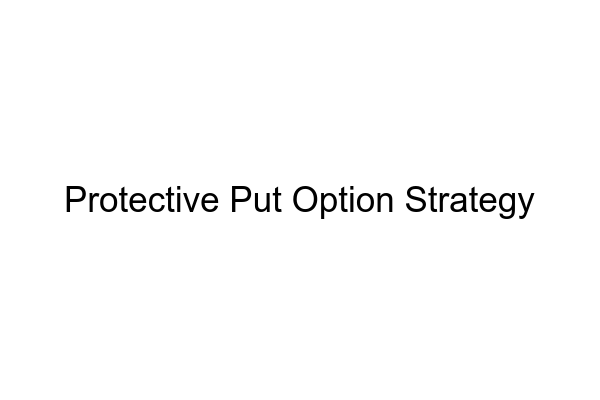Protective Put Option Strategy

What are the characteristics of this option strategy?
Protective Put Option Strategy is an income-producing option trading strategy that involves purchasing a put option and a stock simultaneously. The investor buys the stock to gain appreciation in a bullish market, while the put option limits their downside losses if the stock goes down in a bearish market. The strategy is usually implemented when an investor has an existing long stock position that they want to hedge against potential downside risk.
Is this a bullish, bearish or neutral strategy?
The Protective Put Strategy is a neutral to bullish strategy since it involves buying puts to limit losses from an existing long stock position.
Is this a beginner or an advanced option strategy?
Protective Put Option Strategy is an intermediate-level option strategy since it is not as complex as advanced option strategies but is more complex than beginner option strategies such as covered calls or protective collars.
In what situation will I use this strategy?
Investors typically use this strategy when they have an existing long stock position that they want to hedge against potential downside risk. This strategy allows investors to make money on their long position in a bullish market while limiting their losses in a bearish market. It is especially beneficial in a volatile market.
Where does this strategy typically fall in the range of risk-reward and probability of profit?
In terms of risk-reward, Protective Put Option Strategy generally falls between a conservative income generating strategy and a more aggressive trading strategy. The probability of profit for this strategy depends on the stock price and the strike price of the put option. In addition, the amount of premiums also affects the probability of profit.
How is this strategy affected by the greeks?
The Protective Put Option Strategy is affected by the various greeks, such as delta and vega. Delta measures the change in the option’s value with respect to the underlying stock’s price movement, while vegameasures the change in the option’s value due to a change in the volatility of the stock.
In what volatility regime (i.e VIX level) would this strategy be optimal?
This strategy is optimal in an environment of moderate volatility. The VIX typically needs to be around 20-30 for this strategy to be optimal.
How do I adjust this strategy when the trade goes against me? And how easy or difficult is this strategy to adjust?
If the trade goes against the investor, the investor can adjust the strategy by either closing out the position or rolling it out further in time. This could involve buying a further out the money put option, or rolling the existing option out further. Adjusting the strategy is relatively easy and can be done with limited slippage.
Where does this strategy typically fall in the range of commissions and fees?
Protective Put Option Strategies require commissions and fees, but they are usually fairly low. This is because the strategy involves just one opening transaction and then rolling or closing the position on a single option.
Is this a good option income strategy?
Yes, Protective Put Option Strategy is a good option income strategy. It allows investors to generate income in a bullish or sideways market and protect themselves in a bear market.
How do I know when to exit this strategy?
Investors typically exit this strategy when the stock is at or above the strike price of the option at expiry. Alternatively, investors can exit the strategy prior to expiry if they no longer feel the need to hedge their stock position.
How will market makers respond to this trade being opened?
Market makers will typically provide liquidity in this strategy. They may also use this trade to hedge their own positions, depending on the current market conditions.
What is an example (with calculations) of this strategy?
Suppose an investor buys 100 shares of MSFT stock at $270 per share and buys a $270 put option, which expires in 30 days. The cost of the option is $6.5 per share. The maximum profit the investor can make is the premiums of the option. If the stock jumps to $280, the investor can close the position and make a $350 profit ($3.50 x 100). If the stock drops to $250, the investor will make the loss of $2000 on the stock purchase, but will also make a $1350 profit on the put option exercise since it is in the money.
MarketXLS is a powerful Excel add-in which can help investors to efficiently implement the Protective Put Option Strategy. MarketXLS provides tools such as an option chain to easily search for the best options to use in this strategy and an Option Profit Calculator to help investors calculate their potential profits and losses from the strategy. Investors can also use MarketXLS to monitor the greeks and adjust their strategy as needed.
Conclusion
Protective Put Option Strategy is an income-producing option strategy that allows investors to generate income while limiting their losses in a bearish market. This strategy is best implemented in an environment of moderate volatility and typically falls between a conservative income generating and a more aggressive trading strategy in terms of risk-reward and probability of profit. MarketXLS can help investors to efficiently implement this strategy.
Here are some templates that you can use to create your own models
Protective Put / Synthetic Long Call Option Strategy
Collar Option Strategy
Search for all Templates here: https://marketxls.com/templates/
Relevant blogs that you can read to learn more about the topic
How to Utilize the ThreeWay Collar Hedge
Double Diagonal Option Strategy
Collar Option Strategy – A Synopsis
Collar Option Strategy – A Synopsis
Long Put Option Strategy-Tracking And Managing(With Excel Template)
